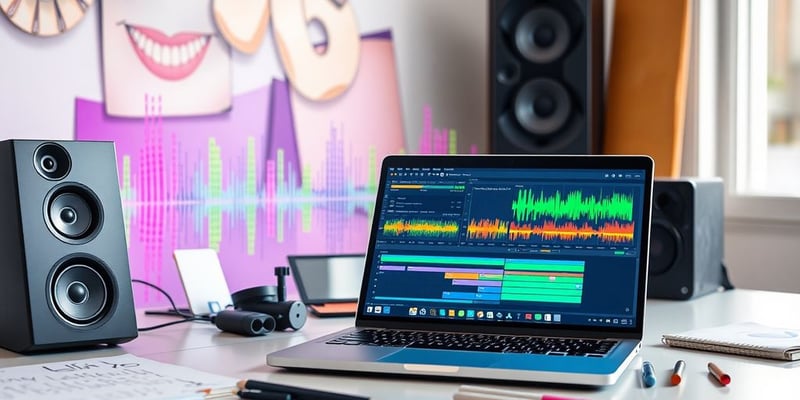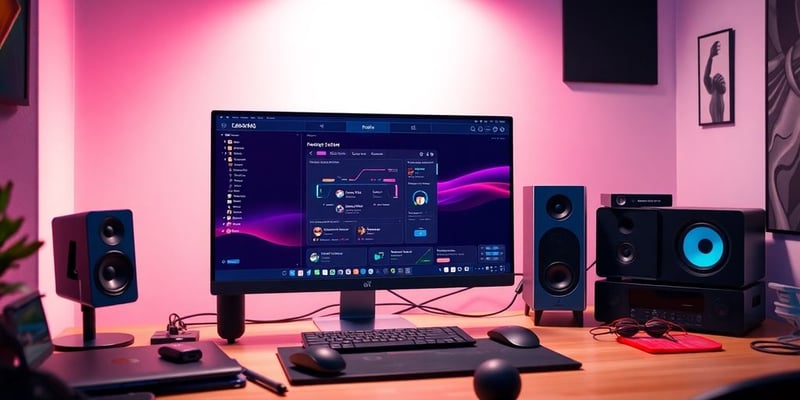
Unlocking Creativity: How an AI Voice Generator Can Transform Your Content Creation in 2025
Save 15%

Ever thought about how much easier content creation could be if you didn't have to spend hours recording voiceovers? Well, in 2025, AI voice generators are making that possible. They're turning written text into speech that sounds almost human. Whether you're narrating a video or making your content accessible to more people, these tools are changing the game. And it's not just about convenience—it's about reaching more people and telling stories in new ways. So, let's take a look at how these AI voice generators are transforming content creation.
Key Takeaways
- AI voice generators are becoming essential tools for content creators, making it easier to produce audio content without needing a recording studio.
- These tools help break down language barriers, making content accessible to a global audience.
- Customization options allow creators to tailor voices to fit different brand personalities and project needs.
- AI voice generators are particularly useful for creating inclusive content, supporting visually impaired audiences and facilitating education.
- Looking ahead, advancements in AI technology promise even more sophisticated voice generation capabilities by 2025.
The Rise of AI Voice Generators in Content Creation
Understanding AI Voice Technology
AI voice generators are tools that transform written text into spoken words using artificial intelligence. They rely heavily on natural language processing to create lifelike, human-sounding audio. This technology has come a long way, with advanced algorithms now capable of mimicking human emotions and subtle nuances in speech. By 2025, generative artificial intelligence is set to revolutionize content creation, changing how we produce and consume content.
Key Benefits for Content Creators
- Efficiency: AI voice generators save time. Instead of spending hours recording, editing, and perfecting audio, creators can quickly convert text to speech.
- Accessibility: These tools make content more accessible by providing audio versions, which is particularly helpful for individuals with visual impairments or learning disabilities.
- Cost-Effective: Hiring voice actors can be expensive. AI offers a budget-friendly alternative that doesn’t compromise on quality.
AI voice generators are not just about replacing human voices; they're about enhancing the creative process. They allow creators to focus on the storytelling aspect, leaving the technicalities of voice production to the machines.
Challenges and Considerations
While AI voice generators offer numerous benefits, they come with challenges. One major concern is the lack of emotional depth compared to a human voice. Although AI can mimic emotions, it often lacks the authenticity of a real person. Additionally, there are ethical considerations around the use of AI-generated voices, such as consent and copyright issues. It's crucial for creators to navigate these challenges thoughtfully, ensuring they use the technology responsibly.
Transforming Storytelling with AI Voice Generators

Enhancing Narrative Techniques
AI voice generators are changing the way stories are told. They allow creators to experiment with different vocal styles and tones, adding a new layer of depth to narratives. Imagine a horror story where the AI voice subtly shifts from calm to eerie, or a children's tale narrated with a warm, friendly voice. These tools can turn a simple story into a captivating experience, engaging listeners in ways traditional narration might not.
Creating Immersive Experiences
With AI voice generators, storytellers can craft immersive worlds. By using diverse voice profiles, creators can give each character a unique voice, making stories more engaging. Whether it's a fantasy world with mythical creatures or a sci-fi adventure in space, these AI tools help bring stories to life. Listeners are transported to these worlds, enhancing their experience as they become part of the story.
Expanding Audience Reach
AI voice generators also help in reaching wider audiences. By offering multilingual capabilities, content can be easily adapted for different regions and languages. This means a story originally in English can be enjoyed by audiences in Japan, Brazil, or Germany, without losing its essence. Plus, these tools can adjust the pacing and tone to suit different cultural preferences, making stories more relatable globally.
AI voice generators are not just about converting text to speech; they're about transforming how stories are shared and experienced, making storytelling more inclusive and dynamic.
AI Voice Generators: A Game-Changer for Accessibility
Breaking Language Barriers
AI voice generators are making it easier than ever to cross language divides. These tools can translate text into speech in multiple languages, allowing content creators to reach a broader audience. Imagine being able to share your story with someone halfway around the world in their native language. That's the power of AI voice generators. Plus, with customizable accents and dialects, the speech sounds more natural and relatable.
Supporting the Visually Impaired
For those who are visually impaired, AI voice generators are a real blessing. They can transform written content into spoken words, making information accessible to everyone. Whether it's reading a book, browsing a website, or even navigating through a smartphone, these tools are opening up a world of possibilities. It's not just about convenience; it's about inclusion and ensuring everyone has the same access to information.
Facilitating Inclusive Education
In the classroom, AI voice generators are changing the game. Teachers can use these tools to create audio versions of their lessons, making learning more inclusive. Whether it's helping students with learning disabilities or those who prefer auditory learning, AI voice generators cater to diverse needs. Educators can now easily generate lesson plans and materials, ensuring no student is left behind.
AI voice generators are not just about technology; they're about making the world a more inclusive place. By breaking down barriers and opening up new possibilities, they are transforming how we communicate and learn.
Customization and Personalization in AI Voice Generation
Tailoring Voices to Fit Your Brand
In the world of content creation, getting the voice just right is crucial. With AI voice generators, you can mold voices to reflect your brand's identity. Whether it's a calm, authoritative tone or a lively, energetic vibe, these tools let you adjust the voice characteristics to match your brand's image. This level of customization ensures that your content resonates with your audience, making it more relatable and engaging. Tools like Genny by LOVO and Hume AI's OCTAVE offer extensive libraries of voices, allowing you to choose styles that align perfectly with your brand's persona.
Adjusting Tone and Emotion
AI voice generators have come a long way, and now they can even mimic emotions in speech. You can tweak the tone to sound happy, sad, or even neutral, depending on the message you want to convey. This flexibility is particularly useful for storytelling or customer service applications. Imagine a customer support bot that can express empathy or excitement as needed. It's all about making interactions feel more human and less robotic.
Leveraging Accents and Dialects
In today's global market, reaching a diverse audience is key. AI voice generators allow you to select various accents and dialects, making your content more accessible and relatable to different demographics. This can be a game-changer for businesses looking to expand their reach internationally. By offering content in multiple accents, you can connect with audiences in a more authentic way, breaking down language barriers and fostering a sense of inclusivity.
Customizing voices isn't just about aesthetics; it's about creating a connection. When your content speaks in a way that feels genuine and familiar, it builds trust and loyalty among your audience. As AI continues to evolve, the possibilities for personalization in voice generation are endless.
Integrating AI Voice Generators into Your Workflow
Streamlining Content Production
Incorporating AI voice generators into your workflow can really speed things up. Imagine not having to spend endless hours recording audio manually. You can just type out your script, and voila, your AI tool transforms it into a polished voiceover. This means more time for other creative tasks. Plus, some tools, like Edcafe AI, offer easy sharing options, which makes collaboration a breeze. You can quickly send your audio files to team members or clients without jumping through hoops.
Collaborating with AI Tools
Working with AI tools doesn't mean you're losing control over your creative process. On the contrary, these tools can be your new best friend. They can handle the repetitive stuff, so you can focus on what you do best - creating. It's like having an assistant who never sleeps. You can even customize the voice to fit your brand's personality, making your content feel more authentic. Tools like Genny by LOVO offer deep customization, allowing you to tweak tone, pitch, and even accents.
Balancing Automation with Creativity
Balancing automation with creativity is key. While AI can handle a lot, it can't replace the human touch. It's important to use these tools to enhance your work, not replace it. Think of AI as a way to free up your time so you can focus on the creative aspects that AI just can't replicate. The goal is to use AI to boost your productivity, not to take over your creative process.
Embrace AI as a partner in your creative journey. It's not about replacing human creativity but enhancing it with new tools and possibilities.
Using AI voice generators can transform your workflow, making it more efficient and freeing up time for creativity. AI significantly enhanced productivity by providing innovative methods to streamline workflows, and this is just one way to adopt those strategies in your own process.
Future Trends in AI Voice Generation

Advancements in Emotional AI
AI voice technology is getting better at understanding and expressing emotions. Imagine a voice that can sound genuinely happy or convincingly sad. This is the future we're heading towards. AI systems are learning to recognize subtle cues in text that hint at emotion and then translate those into voice. This means more natural-sounding voices that can make listeners feel more connected. It's like having a conversation with someone who really gets how you're feeling.
The Role of AI in Multilingual Content
With globalization, there's a huge need for content in multiple languages. AI voice generators are stepping up to this challenge. They're not just translating text; they're adapting the voice to fit different languages and cultures. This means not only getting the words right but also the tone and style that suits the audience. As AI continues to improve, expect more seamless integration of voice and language, making content accessible to a broader audience.
Predictions for 2025 and Beyond
Looking ahead, AI voice generators will likely become more integrated into everyday life. Here are a few predictions:
- Multimodal Integration: Voice, text, and images will come together to create richer, more personalized experiences. The future of AI in 2025 will feature these multimodal search methodologies.
- Increased Accessibility: As the technology becomes more affordable, more people will have access to high-quality voice generation.
- Enhanced Personalization: Users will have more control over how their AI voices sound, from accents to emotional tone.
AI voice generators are not just about making life easier; they're about changing how we interact with technology and each other. As we move forward, they'll continue to break down barriers, making communication more inclusive and personal.
Conclusion
So, here we are, looking at 2025 and the way AI voice generators are shaking things up in content creation. It's pretty wild to think about how far we've come. These tools are making it easier than ever to turn text into speech, and they're doing it in a way that's super accessible. Whether you're a teacher trying to make lessons more engaging or a creator looking to add some flair to your projects, AI voice generators are here to help. But let's not forget, while AI can do a lot, it can't replace the human touch. Our voices, with all their quirks and emotions, are still unmatched. So, as we embrace these new tools, let's use them to amplify our creativity, not replace it. Keep your voice in the mix, and who knows what amazing things you'll create.
Frequently Asked Questions
What is an AI voice generator?
An AI voice generator is a tool that turns written text into spoken words using artificial intelligence. It uses smart technology to make the voice sound human-like.
How do AI voice generators work?
AI voice generators use computer models to read text and create speech. Some let you change the voice's tone, speed, and accent to make it sound more natural.
Can AI voice generators show human emotions?
Yes, some AI voice generators can add feelings like happiness or sadness to the voice. But how well they do this can differ from one tool to another.
Are AI voice generators useful in schools?
Yes! Teachers can use AI voice generators to make reading materials, narrate lessons, and help students learn languages.
Can I use AI-generated voices for my business?
It depends on the tool's rules. Some allow business use, while others might need special permission. Always check before using it for business.
Do AI voice generators save time?
Yes, AI voice generators can quickly turn text into speech, saving you time compared to recording everything manually.









